You provide your customers with support, community, content, and perks, but if you’re not teaching them, you’re missing out on a critical way of engaging them.
Customers are 131% more likely to convert after engaging with early-stage educational content. However, some companies still treat customer education as an afterthought when it should be a key strategy that’s given as much importance as customer service or loyalty programs.
In this blog post, we’ll look at what makes customer education so beneficial to your business, steps you can take to create a strategy, some best practices, and tools to help you along the way.
Try monday sales CRMWhat is customer education?
Customer education, also called customer training, is any type of learning activity a company uses to onboard, train, retain, and new or existing customers.
This can take the form of different types of content and is meant to help customers better use and understand your products or services to get the most value from them so that they relate more positively to your brand.
The importance and benefits of customer education
Informed customers make better decisions and are more likely to stay loyal to your brand. Additionally, establishing customer training activities helps distinguish your company as a leading educational brand. This can have a significant impact on your business’s bottom line as well as your relationship with customers.
Of course, there are many other benefits of customer education that make these learning activities a key to the success of almost any company:
- Better onboarding: Educational content speeds up the customer onboarding process so that new customers are set up for success, improving product adoption rates
- Increased customer loyalty: Customer education keeps customers coming back as they see your brand as an authority, increasing brand awareness and customer loyalty
- Decrease in support costs: When customers are given the tools to learn independently they’re less likely to turn to your service team, saving you costs on support resources.
- Improved customer lifetime value (CLV): Customer lifetime value will improve as customers are more likely to be engaged by your offers, upgrade to a higher-tier product or service, or make repeat purchases.
- Better customer retention: Educated customers know more about your product or service and understand how to use it for their needs, leading to higher retention rates.
How to develop your own customer education strategy
To create a comprehensive customer education strategy, you need to understand your target audience in order to create material that’s relevant to them. Here are some steps to follow to help you build your own customer training strategy.
1. Understand your target audience
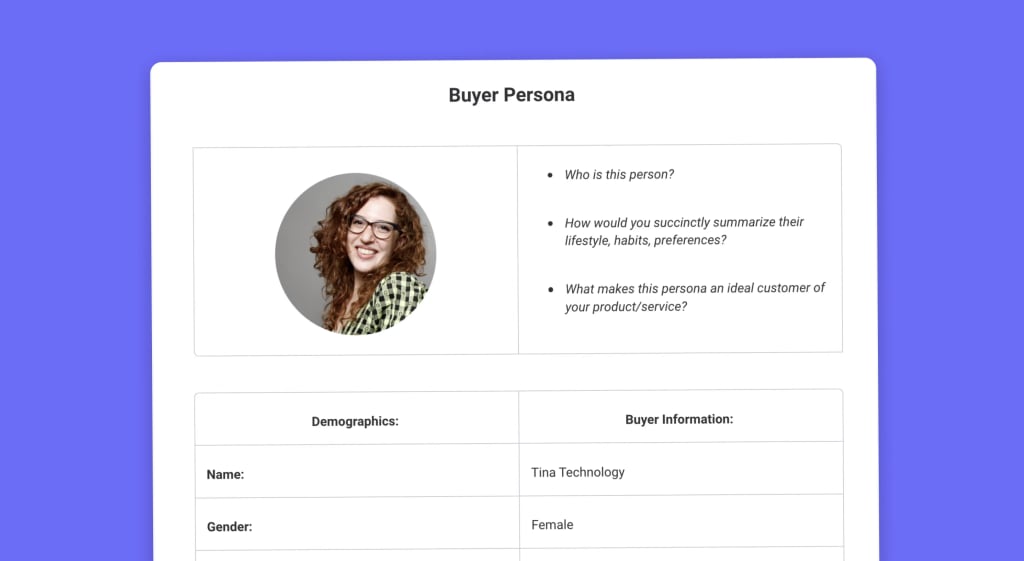
To tailor educational material to your audience to develop impactful programs, you’ll first need to identify the basic characteristics of your customer base, such as their job roles, pain points, and skill levels. To do this, conduct market research, surveys, or interviews to gain insight into their needs and preferences. Once you gather enough data, create a customer persona that you can use to create different segments of your education strategy.
2. Create customer training materials
Next, begin to build out materials that would be beneficial to them. There are many types of learning materials that suit different subject matters and learning styles, such as:
- Written resources: User manuals, guides, walkthroughs, FAQs, case studies, and blogs
- Audio-visual content: Infographics, diagrams, flowcharts, videos, and podcasts
- Interactive content: Webinars, quizzes, simulations, forums, and interactive e-learning modules
Regardless of which type of content you choose, you should make sure they’re clear, easy to understand, visually appealing, and relevant to customers’ pain points.
3. Deliver customer education programs
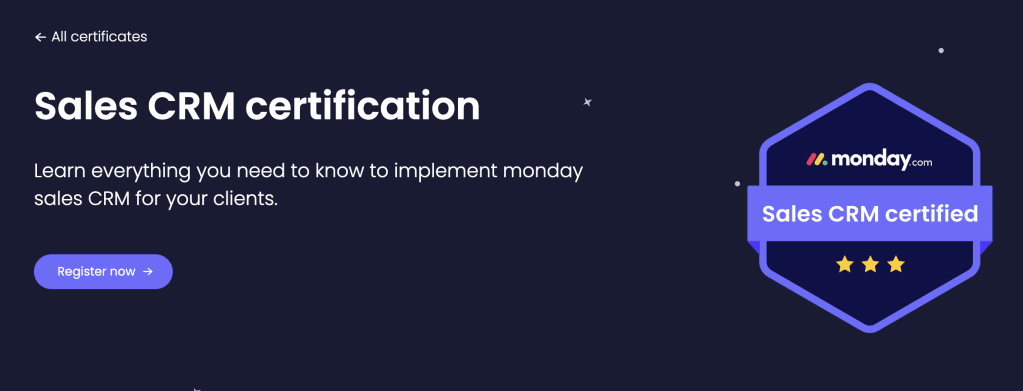
Aside from more one-off training materials, you can create an in-depth education program such as an online academy for long-term learning. These can be a mix of virtual training, online discussions, or self-paced learning. For example, monday.com offers different certifications that help users build skills around the product. Similarly, Hubspot Academy offers a mix of different materials and includes multiple lessons and certifications to deepen user knowledge and improve business skills.
4. Leverage technology for customer education

Especially when you develop complex customer education programs like an academy, the technology you use is important to help you manage it all. A Learning Management System (LMS) can help you manage, organize, and deliver training content efficiently. Aside from an LMS, there are other tools you should consider, such as:
- Video platforms like YouTube or Vimeo to host instructional videos or webinars
- Interactive tools that allow you to create quizzes or online forums
- Analytics tools that enable you to track learner engagement and completion rates
- A CRM system like monday sales CRM helps you manage data on customers to better deliver relevant material
5. Measure the effectiveness of your customer education program
Consistently gather data about your program to see if it’s effective. You can ask for direct feedback from customers after modules, send surveys, or set key performance indicators (KPIs) to see how your business was impacted, such as looking at customer satisfaction rates, support requests, or product adoption statistics. Once you have enough data and analytics, implement regular changes and updates to keep material constantly fresh and relevant.
Best practices for customer education
We’ve covered the benefits of a customer education program and how you can make your own, but let’s take a closer look at how you can make the most of your strategy using best practices.
Make it personal
Training material needs to be engaging so that customers can retain it. The best way to do this is by personalizing it, which you can do by segmenting your audience into groups based on things like industry, role, location, pain point, or skill level. This will allow you to customize material to a group’s specific needs, making for a tailored learning experience.
Define your goals
Focus on one goal at a time for your learning program and make sure it’s aligned with your company’s overall goals. For example, an objective for a customer education program might be to decrease support costs, so your material should aim to provide information on common support tickets. That said, if your business goal is to grow your customer base, your education program should also help move you closer to that by focusing on LTV, customer retention, or outreach.
Consider course length
You don’t want to bombard your customers with long courses or ebooks. Try and keep your content bite-sized so that the material is digestible, flexible, and engaging. Keeping your learning in short snippets, such as focused blog posts or video mini-lessons of 2-5 minutes will also help you ensure your material is mobile optimized so customers can learn on the go.
Sync with your tech
The technology your program uses should be able to sync with the tech your teams rely on, such as an LMS or CRM system.
Ensuring your program integrates with a customer relationship management platform like monday sales CRM will help you manage efforts from different teams like sales and marketing so that you’re offering a better service and are more aligned on goals. Try monday sales CRMHow monday Sales CRM can help with customer education
A good CRM system will help you keep track of your customer education strategy while also ensuring each customer is cared for throughout the process. monday sales CRM comes with a number of built-in features that will help you build a successful customer education strategy while ensuring you can manage, organize, and track all your customers in one place. Here’s a look at some of the features that make this an ideal tool for customer training.
Customer onboarding templates
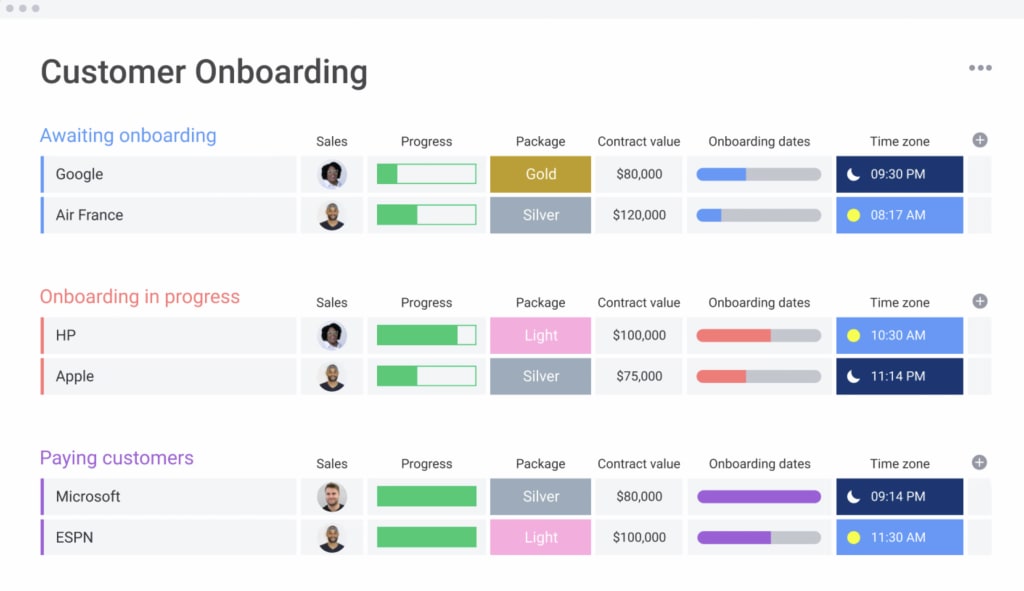
Offering customer training materials during the onboarding process will make adoption smoother and easier. With monday sales CRM, you can start with an onboarding template that will help you track each customer’s journey so you can offer a tailored learning experience that fits each customer’s journey.
Custom boards to manage learning materials
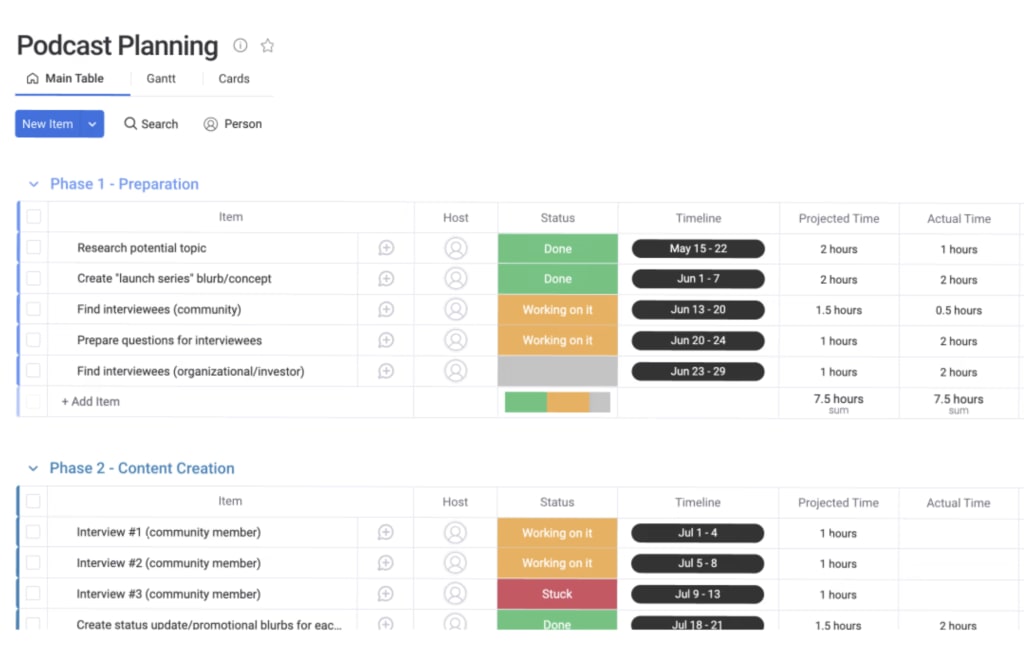
Organization of your learning materials is key, especially if you’re going to use a mix of mediums like videos, blogs, ebooks, and webinars to educate customers. Organizing your content in monday sales CRM helps you stay on top of everything whether the learning material is ready to go live, still needs some tweaks, or it’s in the pipeline.
Customized automations to ease material distribution
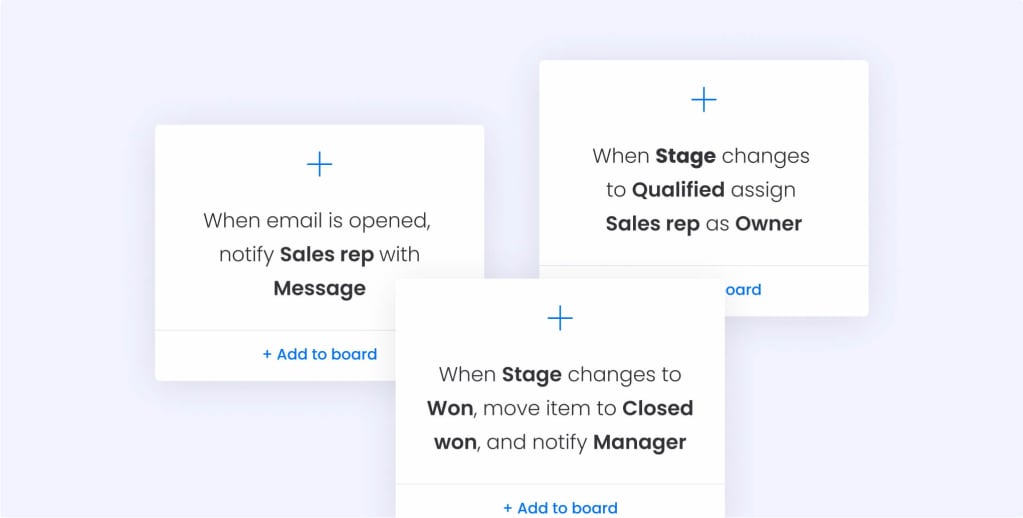
Not only is monday sales CRM an ideal platform to use to organize customer data you collect but it can also be used to better distribute material. Create customized automations that get triggered with specific actions, so for example, when a customer is listed in a specific onboarding stage, you can trigger an automatic email to be sent to them that contains links to educational material that’s tailored to exactly where they are in their journey.
monday sales CRM helps you grow your customer education strategy
Customer education is a worthwhile investment for a variety of business goals. At the end of the day, a more educated customer is a happier customer, and happy customers are more likely to stay with your business. That said, customer training programs can be a big undertaking, so using a platform like monday sales CRM helps you keep all your customer education goals, projects, materials, and data organized in one place.
FAQs
Why is it important to educate the customer?
Educating your customers helps establish trust, builds relationships, and creates brand loyalty while helping the customer stay informed on your products or services so that it gives them better value.
What are the goals of customer education?
Customer education increases customer loyalty and satisfaction, brings down customer support costs, improves customer retention and lifetime value, and helps with onboarding.
How do you educate customers about your product?
Use a mix of different content such as webinars, guides, blogs, walkthroughs, online forums, and more to help educate customers about your product.
